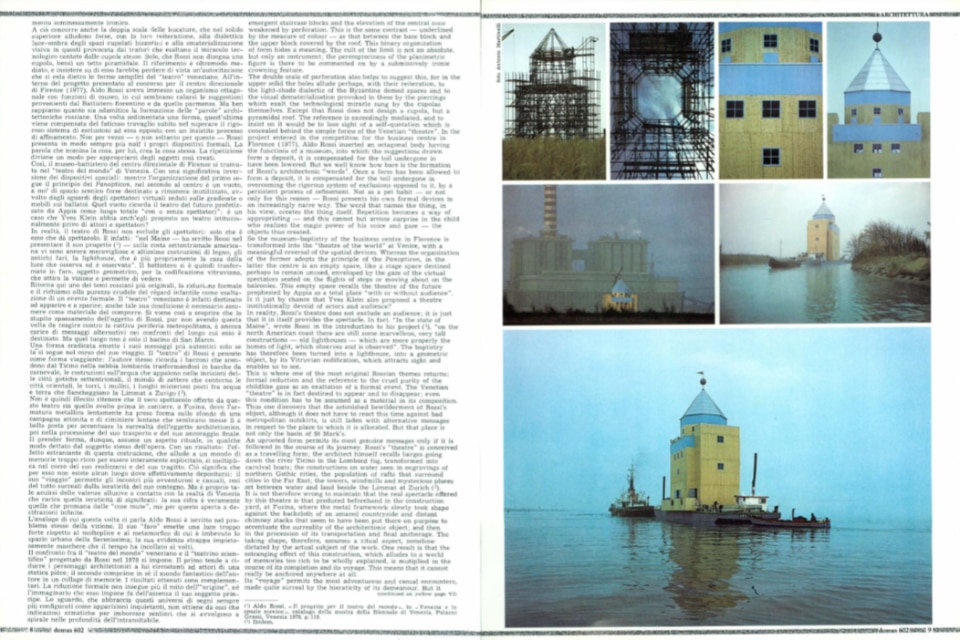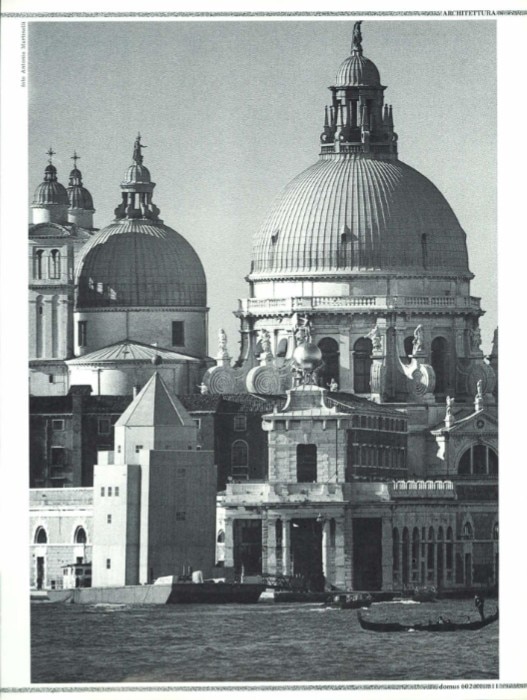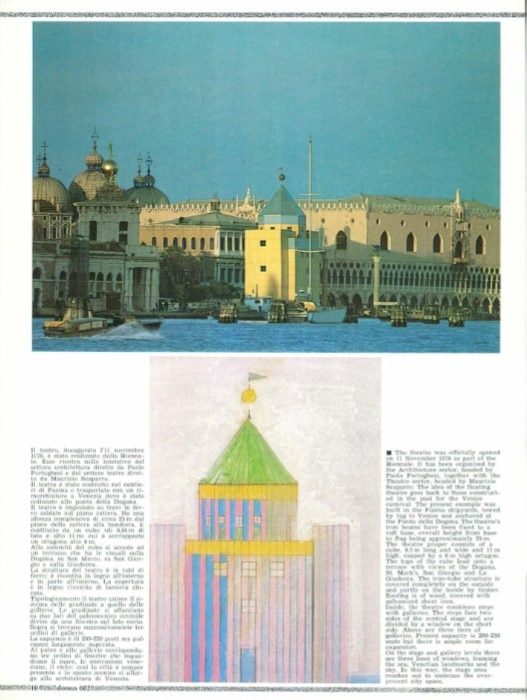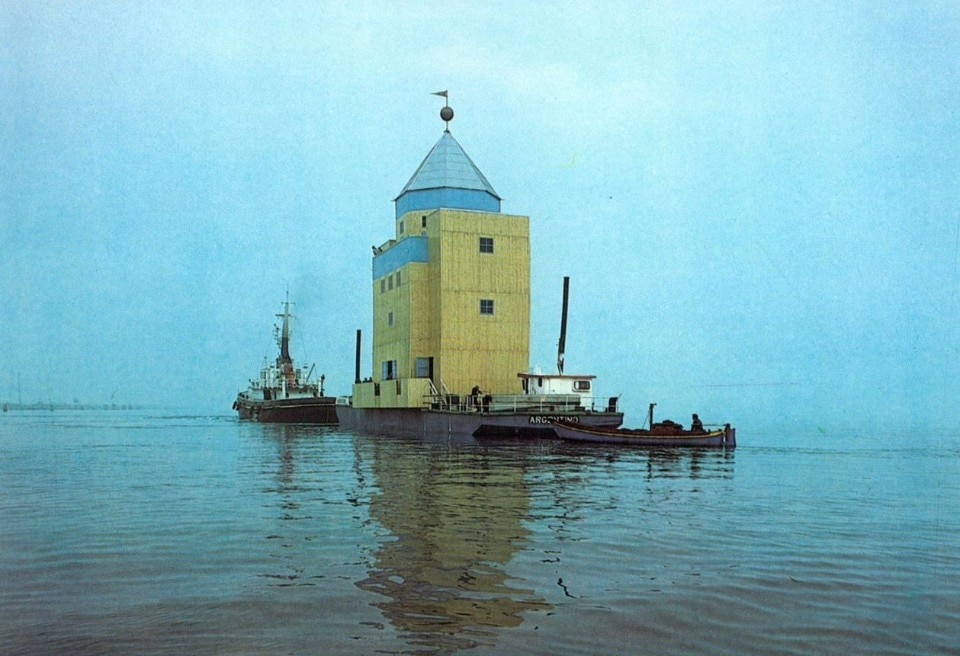The first Venice Architecture Biennale, in 1980, not only did represent the beginning of a story that will soon enter its eighteenth chapter, but would also become an immediate collector of milestones and founding images for contemporary architectural theory. The Strada Novissima set up at the Corderie dell'Arsenale appears in all architectural history textbooks as an anthology and epitome of the global emergence of postmodernism, and a similarly disruptive effect would be generated by the contribution of a great creator of icons, Aldo Rossi: a floating architecture sailing the Venice Lagoon already in November 1979 on the occasion of the exhibition Venezia e lo spazio scenico (Venice and the Scenic Space), commissioned by the Theater division and the Architecture division – directed by Paolo Portoghesi and soon to open the Architecture Biennale – destined to become a symbol, perhaps more than all the other projects that accompanied it. Ephemeral and archetypal, the Teatro del Mondo (Theater of the World) catalyzed structural themes of the Italian theoretical debate of the following years, such as the ephemeral and the archetype themselves, but also the timelessness of forms and – as the exhibition would title – the presence of the past. Historian and critic Manfredo Tafuri would be the first to dive deep into the critical complexity generated by this project, with an essay that recently deserved a dedicated re-reading, by historian Fulvio Irace, published in 2020 on Domus 1051. The original essay came out instead on issue 602, in January 1980.

L’éphémère est éternel. Aldo Rossi in Venice
In Venice, city of promises not kept with the sacred masters of contemporary architecture, Aldo Rossi has found a way of giving life to an object satisfied with its nonessentiality. “World Theatre” paying homage to a favourite theme of the theatre tradition of sixteenth century Venice, Rossi’s “planita” owes its ephemeral existence to the uncertain programmes of the Biennale. And yet, destined to float for a few months on the waters of the lagoon, Aldo Rossi’s object makes its confusing situation into a reason for being.
The reference to the sixteenth century Theatrum Mundi is therefore only a literary one. The engravings which document the provisional “theatres” erected by Rusconi and Scamozzi show outdoor forms, allusions to a cosmogonic totality dissimulated under the typical jesting gloss of the festive apparatus, exaltations of centrality dissolved in figurations and in transparencies that speak of the Venitian Republic’s traditional mask as a primary and everlasting value. Not by chance the Theatrum Mundi is connected to the ars memoriae. Its dramatic contribution to Venice is the marriage of Utopia – the globality of the experience promised by a central space – to the phenomenal, the relative, the transient, embodied by the provisional character of the stage “machine”. Rusconi’s “theatre” is symptomatic in this respect. The caryatids which melt the absoluteness of the circular tolos into narration permit a warm involvement in the rite through which the composite Venetian collectivity is unified and recognizes itself. Memory here is in direct communication with the myth of Venice’s “freedom”: the absolute is mirrored in a dissolving of limits; the substance does not come into conflict with the appearance.

This is not the memory to which Rossi’s “theatre” refers. On the contrary, the theatre does not seem to contain any allusions to the fluidity of Venetian scenic space, nor does its structure enter into any consonance with the web of kinetic paths that give concreteness to the continuity between the urban lagoon setting and the late-Roman Kunstwollen. Indeed, one can say more. Rossi’s closed and frozen form, destined to appear temporarily as an instant object in the polyphonic space of St Mark’s basin contains in itself a homage to the sense of limit, to the Albertian concept of finitio, which is specifically anti-Venetian. Nevertheless, Palladio had appealed to that self-same finitio in defining the edges of St Mark’s basin. On the horizon, like over-concluded dreams in themselves, the shapes of the Redentore and of San Giorgio Maggiore stand out, contrasting the impressionism of the urban imagerie with their calculated play of interpenetrations.
The tonality of this play is austere for Palladio. Even when his architecture takes the form of a provisional stage machine – and I refer to the triumphal arch and to the Corinthian loggia erected by him in 1574 at the Venice Lido for the entry of Henry III of Valois – it is the organic quality of the syntax which takes on a leading role.
With a Palladian attitude, Aldo Rossi “comes down” to Venice. And not only though the spatial organization of this “theatre”, which, by its symmetry on a single axis, the adjacency of its staircase blocks to the central hall and by its binary structure – a cubic space surmounted by a pointed octagonal prism – manifestly quotes the formal dialectics of Villa Capra at Vicenza. What is Palladian, on the other hand, is his refusal to be dragged into the vortex of involvement towards which Venetian spatiality tends to exercise its attraction. The only adventure which Rossi allows himself is that engendered by the dangerous encounter between the rigorous consistency of his object and the triumphal fullness of the “chorus”, which accompanies the “solos” of the Piazzetta, the Salute, and the churches that give thicknesse to the “edge” of the Giudecca. Indeed it is difficult at this point to accept the cultural reference to the Theatrum Mundi. The graphic line of Rossi’s object is fragile; the direction lines of his organism are strong. Observe the contrast between the emergent staircase blocks and the elevation of tne central zone weakened by perforation. This is the same contrast — underlined by the measure of colour – as that between the base block and the upper block covered by the roof. This binary organization of form hides a meaning. The cult of the limit is not an absolute, but only an instrument; the peremptoriness of the planimetric figure is there to be commented on by a submissively ironic crowning feature.
The double scale of perforation also helps to suggest this, for in the upper solid the holes allude perhaps, with their reiteration, to the light-shade dialectic of the Byzantine domed spaces and to the visual dematerialization provoked in these by the piercings which exalt the technological miracle sung by the cupolas themselves. Except that Rossi does not design a cupola, but a pyramidal roof. The reference is exceedingly mediated, and to insist on it would be to lose sight of a self-quotation which is concealed behind the simple forms of the Venetian “theatre”. In the project entered in the competition for the business centre in Florence (1977), Aldo Rossi inserted an octagonal body having the functions of a museum, into which the suggestions drawn form a deposit, it is compensated for the toil undergone in have been lowered. But we well know how bare is the formation of Rossi’s architectonic “words”. Once a form has been allowed to form a deposit, it is compensated for the toil undergone in overcoming the rigorous system of exclusions opposed to it, by a persistent process of refinement. Not as a pet habit – or not only for this reason – Rossi presents his own formal devices in an increasingly naive way. The word that names the thing, in his view, creates the thing itself. Repetition becomes a way of appropriating – and this cannot but arouse surprise in the child who realizes the magic power of his voice and gaze – the objects thus created.
So the museum-baptistry of the business centre in Florence is transformed into the “theatre of the world” at Venice, with a meaningful reversal of the spatial devices. Whereas the organization of the former adopts the principle of the Panopticon, in the latter the centre is an empty space, like a stage space destined perhaps to remain unused, enveloped by the gaze of the virtual spectators seated on the flights of steps or moving about on the balconies. This empty space recalls the theatre of the future prophesied by Appia as a total place “with or without audience”. Is it just by chance that Yves Klein also proposed a theatre institutionally devoid of actors and audience? In reality, Rossi’s theatre does not exclude an audience; it is just that it in itself provides the spectacle. In fact. “In the state of Maine”, wrote Rossi in the introduction to his project, “on the north American coast there are still some marvellous, very tall constructions – old lighthouses – which are more properly the homes of light, which observes and is observed”. The baptistry has therefore been turned into a lighthouse, into a geometric object, by its Vitruvian codification, which attracts sight and enables us to see.

This is where one of the most original Rossian themes returns: formal reduction and the reference to the cruel purity of the childlike gaze as an exaltation of a formal event. The Venetian “theatre” is in fact destined to appear and to disappear; even this condition has to be assumed as a material in its composition. Thus one discovers that the astonished bewilderment of Rossi’s object, although it does not have to react this time against bad metropolitan outskirts, is still laden with alternative messages in respect to the place to which it is allocated. But that place is not only the basin of St Mark’s.
An uprooted form permits its most genuine messages only if it is followed in the course of its journey. Rossi’s “theatre” is conceived as a travelling form; the architect himself recalls barges going down the river Ticino in the Lombard fog, transformed into carnival boats; the constructions on water seen in engravings of northern Gothic cities, the population of rafts that surround cities in the Far East; the towers, windmills and mysterious places set between water and land beside the Limmat at Zurich. It is not therefore wrong to maintain that the real spectacle offered by this theatre is that produced beforehand in the construction yard, at Fusina, where the metal framework slowly took shape against the backcloth of an amazed countryside and distant chimney stacks that seem to have been put there on purpose to accentuate the surreality of the architectonic object; and then in the procession of its transportation and final anchorage. The taking shape, therefore, assumes a ritual aspect, somehow dictated by the actual subject of the work. One result is that the estranging effect of this construction, which alludes to a world of memories too rich to be wholly explained, is mutiplied in the course of its completion and its voyage. This means that it cannot really be anchored anywhere at all.
Its “voyage” permits the most adventurous and casual encounters, made quite surreal by the hieraticity of its demeanour. But it is precisely this sharpening of ollusive valences in contact with the reality of Venice which charges that hieraricity with meanings; its cypher is really that which issues from “silent things”, but is for this reason open to infinite deciphering. The analogue about which Aldo Rossi talks to us this time is inscribed within the problem of vision itself. His “lighthouse” gives out too strong a light compared to the multiple and to the metamorphic with which the urban space of the Serenissima is imbued; its evidence ruthlessly tears the masks which time – denied by the suspended tonality of the “theatre” – has glued to the faces.
The comparison between the Venetian “theatre of the world” and the “scientific theatre” designed by Rossi in 1978 has become necessary. The former tends to reduce the architectonic figures surrounding it to actors in a static performance; the latter compresses into itself the architect’s fantastic world in a collage of memories. The results obtained are complementary. The formal reduction no longer pursues the myth of “origin” nor does the imagery which it imposes make absence its main subject. The gaze, which sweeps across these universes of signs, increasingly arranged like disquieting apparitions, obtains nothing from these but hermetic indications for following paths that envelop each other spirally in the depths of the impassable.
The theatre was officially opened on 11 November 1979 as part of the Biennale. It has been organized by the Architecture sector, headed by Paolo Portoghesi, together with the Theatre sector, headed by Maurizio Scaparro. The idea of the floating theatre goes back to those constructed in the past for the Venice carnival. The present example was built in the Fusina shipyards, towed by tug to Venice and anchored at the Punta della Dogana. The theatre’s iron beams have been fixed to a raft base, overall height from base to flag being approximately 25 m. The theatre proper consists of a cube, 9.5 m long and wide and 11 m high, capped by a 6 m high octagon. The tops of the cube lead onto a terrace with views of the Dogana, St. Mark’s, San Giorgio and La Giudecca. The iron-tube structure is covered completely on the outside and partly on the inside by timber. Roofing is of wood, covered with galvanized sheet iron. Inside, the theatre combines steps with galleries. The steps face two sides of the central stage and are divided by a window on the short side. Above are three tiers of galleries. Present capacity is 200-250 seats but there is ample room for expansion. On the stage and gallery levels there are three lines of windows, framing the sea, Venetian landmarks and the sky. In this way, the stage area reaches out to embrace the ever-present city space.
Opening image: from Domus 602, January 1980


